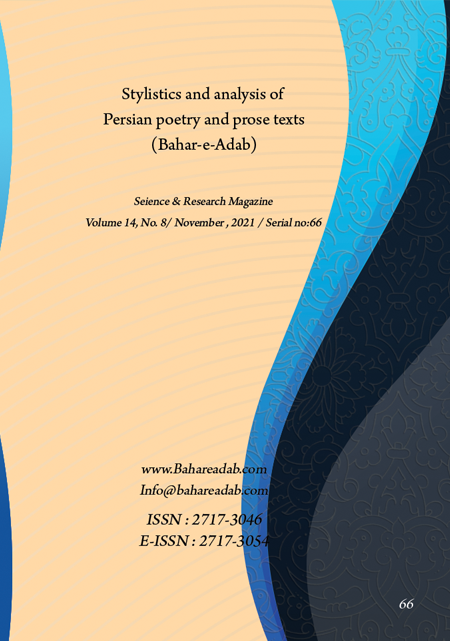- Count View : 376
- آدرس کوتاه شده مقاله: https://bahareadab.com/article_id/1166
- کد doi مقاله: Doi: 10.22034/bahareadab.2021 .14 .6130
Journal of the stylistic of Persian poem and prose
volume Number 14،
number In Volume 8،
،
issue Number 66
The do's and don'ts of behavior in Shams's articles in connection with his ontological view
Ali Azizi (Author in Charge), Davood Spraham
Abstract
BACKGROUND AND OBJECTIVES: Spiritual journey can be considered as the most important pillar of Sufism and mysticism and as the feature distinguishing it from other religious systems. So, a great part of Sofieh teachings has been centered on defining and explicating this spiritual journey. Existence of different steps in the evolutional journey not only superficialy indicates the existence of rituals, attitudes and educational systems, but also is in depth an influence of Sufis’ ontological view (as the one who plans the journey for his followers). Therefore, the place of God and Man in the hierarchy of the being and the relationship between these two plays a crucial role in howabouts of the journey.
METHODOLOGY: This research was conducted in a descriptive-analytical manner using library resources.
FINDINGS: Shams Tabrizi is one of the influential Sufis of the middle Ages. He is also regarded as an innovative and creative mystic in areas of anthropology, theology and ontology. In many regards, for example in terms of spiritual journey he has new and innovative ideas that deserve more attention. He believes that man has fallen apart from his true place, which is Khaliftulah. Therefore, he can regain his position through doing some actions and avoiding some other actions.
CONCLUSION: Shams’ teachings regarding spiritual journey can be divided into two categories: 1) What the seeker should pay attention to on the outside and in the material life (human journey in society) 2) what should happen in the heart and mind of the seeker (inner journey). In the first case, what is most important is the feeling of an inner need and a relationship based on love and knowledge of hijab, and te external requirement which must be observed by the seeker is choosing a guru.
Keyword
Shams Tabrizi
, Maghalat
, God
, Journey
, Ontology
- The Holy Quran.
- Attar, F. (2012). Tazkerat al- Awlliya. Corrected by Mohammad Estelami. Twenty-third edition, Tehran: Zavvar, P.551.
- Chitick, W. (2005). The Sufi Way of Love. Translated by Mehdi Sarreshtari, Tehran: Mehr Andish, p.21.
- Dehkhoda, A.A. (1999). Dictionary. Tehran: University of Tehran.
- Dessler, D. (1989). Whats at the stake in the Agent-structure Debate? international organization, P.43.
- Hojviri, A. (2012). Kashf al-Mahjoub. Tehran: Soroush, p.58.
- Ibn al-Arabi, M. (2015). Al-Futuhat Al-Makkiye, Tehran: Mowla, p.380.
- Kashi, A. (2000). Latif al-Alam, Published by Majid Hadizadeh, Tehran: Miras Maktob, P. 124.
- Lotfi, M.H. (2019). The Period of Plato, Tehran: Kharazmi, P. 197.
- Maulana, J. (1998). Masnavi. By Nasrullah Pourjavadi. Tehran: Amir Kabir, P.207.
- Movahed, M.A. (2007). A story of stories. The oldest narration of the story of Shams and Rumi, Tehran: Karnameh, p. 37.
- Movahed, M.A. (2008). Green Garden. Talks about Shams and Rumi. Tehran: Karnameh, p.208.
- Nasafi, E. (1984). Ensan Kamel. 2 nd ed, Tehran: Tahori, p.40.
- Nasr, S. H. (1992). Theoretical mysticism and conduct in Sufism, Irannameh, 11 (1), pp. 121-128.
- Onuf, N. (2002), Worlds of our making: The strange career of constructivisim in international relatiins, In Puchala ed, p.126.
- Sajjadi, S.Z. (2013). An introduction to the basics of mysticism and Sufism, Tehran: Tadvin Kotob, p.452.
- Sana’ie, A. M. (1975). Koliyat Sana’ie, edited by Modarres Razavi, Tehran: Sanai Library, p.51.
- Shams, M. (2008). Introduction to Epistemology, Tehran: Tarhe no, p. 53.
- Solami, A R. (1953). Tabaghat al Sofieh. research by Nou r al-Din Shariba, Egypt: Dar al-Fikr.
- Tabrizi, S.M. (2012). Maghalat. Editor: Mohammad Ali Movahed. 4th ed, Tehran: Kharazmi.
- Tafazzoli, T. (1974). Investigation and research on the letter of Mohieddin ibn Arabi to Fakhr Razi. University of Tehran Journal, Number 3, pp.146-197.
- Toshihiko, I. (1995). God and Man in the Qur'an: The Semantics of the Qur'anic Worldview, Translator Ahmad Aram, Tehran: Sahami enteshar, pp. 91-92.

